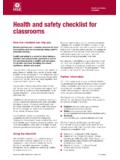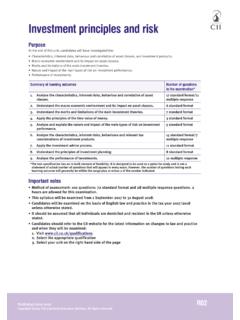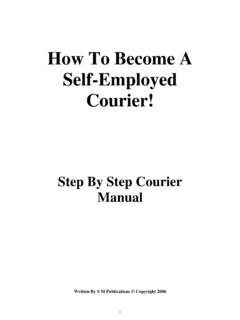Transcription of Preventing injuries from the manual handling of sharp ...
1 Preventing injuries from the manual handling of sharp edges in the engineering industry Introduction manual handling of articles with sharp edges Cause as many as a third of all accidents in some engineering workshops resulting in cuts, abrasions, infected wounds, dermatitis, amputations and occasionally fractures. Even minor incidents can result in the injured person being away from work for some days or transferring to lighter duties. Problems can also occur with infections of uncovered cuts or contamination of cuts with chemicals. Hazards Contact with sharp edges is routine in many engineering jobs. injuries are common: where people are involved in handling sheet or strip metal;. during work at presses, where small pieces of metal with sharp edges are handled frequently.
2 From accidental contact with scrap metal, banding or swarf, principally during cleaning and disposal;. by contact with machinery blades, cutters or tools (for example when fitting, removing, cleaning or storing). Those most at risk include: stores and warehouse staff;. tool setters, maintenance workers;. operators of machines such as presses, guillotines, and steel-slitting lines where sheet steel is often manipulated by hand welders who have to move or hold items being worked on. Working practices of these employees should be examined carefully to determine the level of risk, including: where there may be sharp edges;. the weight of objects being handled and which parts of the body are most at risk.
3 Is it just the hands or could the lower limbs also be affected? whether the handler has to walk up or down stairs, or through an awkward gap? Is the floor even and free from obstruction, or liquid on which people might slip? whether there may be potential for secondary contamination or infection, for example where sharp -edged items are being jigged in metal-finishing workshops. Reducing the risks Where risk of injury is identified, appropriate measures should be introduced. Try working through the list below. You should consider each possibility and decide whether it is reasonably practicable for you to take the steps outlined: ask your supplier to remove or protect sharp edges on material being supplied, eg by machining out sharp edges or fitting plastic covers or padding.
4 Engineer out sharp edges produced during your process, tooling could be designed to minimise sharp edges, or edges of metal strip could be dressed or rolled, or edges of large items could be ground or sanded; or protect them before handling avoid handling by using, for example, trays, jigs, holders, tongs, hooks, baskets, hoists, trolleys or lift trucks;. minimise handling by automating processes by using, for example, conveyor belts, feed and discharge chutes, automatic feeds and air ejection systems (although the latter may increase noise risks). remove scrap with a rake or shovel, and swarf with a tool or brush;. store articles correctly so that they are retrieved easily;. use personal protective equipment (PPE).
5 This might include gloves, gauntlets and armbands. All PPE must be suitable for the circumstances, taking into account the range of employees who will use it, as well as the nature of the task, the load and the working environment. The use of gloves Remember that gloves can pose a serious entanglement risk at drilling machines and other machinery with rotating parts. These machines should be effectively guarded and gloves must not be worn where there is a risk of entanglement. Insides of gloves should be kept clean, free from swarf and substances which may cause cuts or irritation. The use of gloves should be a last resort, or where there is still a residual risk despite the introduction of engineering controls.
6 Guidance on the selection of gloves can be found at Training and supervision Whatever control measures you decide on, your employees will need to be trained how to use them. Systems of work may be needed for cleaning and maintenance of machinery when this results in contact with swarf or sharp material. The use of gloves and other control measures by employees should be enforced where a risk assessment indicates a need for them. All employees have legal responsibilities to co-operate with you and use the control measures provided, including PPE. Managers and supervisory staff should be active in encouraging and enforcing the use of PPE where appropriate. Further information For information about health and safety, or to report inconsistencies or inaccuracies in this guidance, visit You can view HSE guidance online and order priced publications from the website.
7 HSE priced publications are also available from bookshops. This guidance is issued by the Health and Safety Executive. Following the guidance is not compulsory, unless specifically stated, and you are free to take other action. But if you do follow the guidance you will normally be doing enough to comply with the law. Health and safety inspectors seek to secure compliance with the law and may refer to this guidance. This document is available at: More information about MSDs is available at: More information about the selection of gloves is available at: manual handling at work: A brief guide INDG143 manual handling - Solutions you can handle 1994 HSE Books ISBN 0 7176 0693 7. Health and safety in engineering workshops 1995 HSE Books ISBN 0 7176 0880 8.














